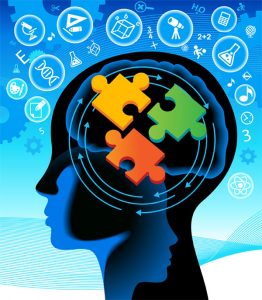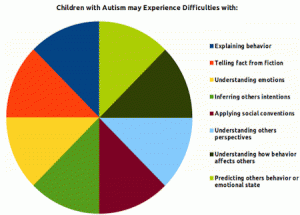 क्या आप जानते हैं की विश्व स्वास्थ्य संगठन ( WHO) के अनुसार पूरी दुनिया में प्रति १६० बच्चों में से १ बच्चा ऑटिज्म नामक न्यूरोडेवलपमेंटल विकार से पीड़ित हैं।
क्या आप जानते हैं की विश्व स्वास्थ्य संगठन ( WHO) के अनुसार पूरी दुनिया में प्रति १६० बच्चों में से १ बच्चा ऑटिज्म नामक न्यूरोडेवलपमेंटल विकार से पीड़ित हैं।
दिनोंदिन तेजी से इस सामाजिक- मानसिक विकार से ग्रसित बच्चों की संख्या बढ़ती ही जा रही है। कुछ रिसर्चेस के निष्कर्षों के आधार पर यह सामने आया है की किन्ही अनुवांशिक कारणों एवं प्राकृतिक बदलाव की वजह से यह डिसऑर्डर होता है.
जहाँ अमेरिका में यह आंकडा प्रति ६० मे से १ है, ब्रिटेन में १०० में से १, कोरिया में प्रति ३८ में १ है, वहीं हमारे भारत में जागरूकता एवं डायग्नोसिस के अभाव तथा राष्ट्रीय स्तर पर सर्वेक्षण नहीं होने से कोई स्पष्ट आंकडे तो नहीं है, परंतु इंटरनेशनल इपिडेमियोलाजिकल रिसर्च सेंटर (IERC) द्वारा दी गई जानकारी के अनुसार हमारे देश में भी प्रति १५० से ३०० बच्चों के बीच १ बच्चा ऑटिज्म स्पेक्ट्रम डिसआर्डर से ग्रसित है।

वहीं लिंगानुपात के मुताबिक लड़कियों की अपेक्षा लड़कों में यह पॉंच गुना अधिक होता है। आटिज्म एक बहुत विस्तृत विकार है जिसमे की अलग -अलग बच्चों में कई तरह की “टिपिकल” क्रियाएं देखने को मिलती है.
बच्चों में तेजी से बढ़ते जा रहे इस डिसआर्डर के बारे में जागरूकता फैलाने के उद्देश्य से संयुक्त राष्ट्र संघ ( United Nations) के तत्वावधान में अप्रैल माह को ऑटिज्म माह के रूप मनाया जाता है, तथा “World Autism Awareness Day” का आयोजन दिनांक २ अप्रैल को किया जाता है। तथा इस विकार से ग्रसित व्यक्तियों के प्रति *संवेदनशीलता दर्शाने के लिए दुनियाभर की प्रमुख इमारतों को “Light It Up Blue” कैंपेन के अंतर्गत नीली रोशनी से सजाया जाता है।
All children with autism have problems with 3 major areas –
Social Interaction
Verbal and Nonverbal Communication
Repetitive Behaviors or Interests
ऑटिज्म के लक्षण( Early Signs of Autism Spectrum Disorder) बच्चे के विकास की प्रारंभिक अवस्था ( ८ माह से पॉंच वर्ष की आयु) से दिखाई देने लगते हैं जैसे –
*सामाजिक मेल मिलाप की कमी*, बच्चा ज्यादातर दूसरों से अलग (कट ऑफ) रहना पसंद करता है

*लेक ऑफ स्पीच* ( बहुत कम या फिर बिल्कुल ही नहीं बोलना)
*आइ कांटेक्ट नहीं होना/ कम होना* ( दूसरे व्यक्तियों से बात करते वक्त नजर नहीं मिलाना)
अन्य बच्चों की अपेक्षा *स्लो* प्रतीत होना
*परिजनों के प्रति अलूफ रहना*(माता-पिता से कम अटेचमेंट)
*एक ही तरह के खेल खेलना*
बहुत *जिद्दी होना*, भोजन / कपडों में *बहुत सिलेक्टिव* होना

अपनी *जरूरतों को एक्सप्रेस नहीं कर पाना*, अन्य व्यक्तियों की feelings/ expressions को नहीं समझ पाना आदि।
*सेल्फ हार्मिंग बिहेवियर* (स्वयं को काटना/ नोचना)
किसी भी प्रकार का डर नहीं होना ( ऊँचाई से गिरने का/ चोट लगने का)
*अन्य लक्षणों में शामिल हैं*
*एकटक किसी चित्र/ रंग/ रोशनी को देखते रहना*
*अपने हाथों को देखते रहना*
*एक ही स्थान पर गोल गोल घुमना*

*ध्वनियों/ आवाज के प्रति अति-संवेदनशीलता*
*खिलौनों के बजाए बर्तनों/ चाबी/ हेयर कि्लप / औजारों से खेलना*
*पढ़ाई में कमजोर होना*
*अपने आसपास मौजूद वस्तुओं को एक लाइन में जमाने लगना*
*तेजी से कहीं भी उछलने लगना*
*सड़क/ पार्क/ पब्लिक प्लेसेस पर ही जमीन पर लोटने लगना*
*प्लास्टिक/ कागज/ पन्नी/ मिट्टी चबाना*

ऑटिज्म एक गंभीर मस्तिष्क से जुड़ा हुआ विकार है जिसका वर्तमान में कोई निश्चित ईलाज उपलब्ध नहीं है..
परंतु अर्ली एज में लक्षणों की पहचान होने एवं विभिन्न प्रकार की रेमेडियल एंव बिहेवियर थैरेपी के द्वारा ऑटिज्म से पीड़ित बच्चे भी समाज की मुख्यधारा में सम्मिलित हो सकते है।

Treatment of Autism include certain medications for irritability, hyperactivity, anxiety n depression.
Behaviour Modification Therapy, Occupational Therapy, Sensory Integration Therapy, Special Education, ABA, Play Therapy, Recreational Therapy, Early Intervention Programs are helpful.
Children with Autism are unique in themselves, n they can also lead a fruitful life.
So it is very important to have understanding regarding the typical signs which the children with Autism shows..
Always remember that these children will need your support, understanding and encouragement in every sphere of their lives…
Stay Healthy..
Dr. Pooja Pathak
www.facebook.com/swavalambanchildrenrehab















